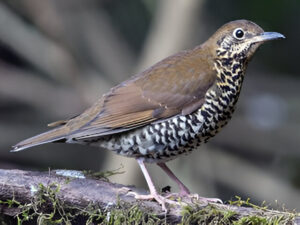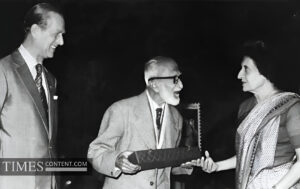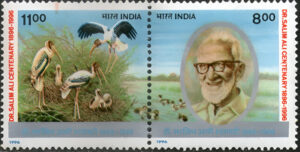“Birdman” Dr. Salim Ali
@Asim Deb
Dr. Salim Ali, one of the greatest ornithologists and naturalists of all time, was one of the very first scientists to carry out systematic bird surveys in India and abroad.
Zoothera Salimalii, the bird is named after Indian of ornithologists Dr. Salim Ali. In 2016 the international group of ornithologists named the newly discovered species after him, thus paying homage to the man who shaped generations of ornithologists and contributed to the better understanding of birds. The research team that identified the species included scientists from Sweden, India, China, the U.S., and Russia. Himalayan Forest Thrush, Zoothera Salimalii, thus goes the name of the species, which has been described from north-eastern India and adjacent parts.

Salim Moizuddin Abdul Ali was born on November 12, 1896. Orphaned at a very young age, Salim Ali was brought up by his maternal uncle, Amiruddin Tyabji, who was a keen hunter and nature-lover. Under his guidance young Salim learnt his first lessons in hunting and could see the nature around him.
As a 10-year-old boy, Salim once noticed a flying bird and shot it down. Tender at heart, he instantly ran and picked it up. It appeared like a house sparrow, but had a strange yellowish shade on the throat. Curious, he showed the sparrow to his uncle Amiruddin and questioned him about the bird’s kind. Unable to answer, his uncle took him to W.S. Millard, the Honorary Secretary of the Bombay Natural History Society. Amazed at the unusual interest of the young boy, Millard took him to show many stuffed birds. When Salim finally saw a bird similar to the child’s bird, he got very excited. That was the beginning, and young Salim started visiting the place frequently.
Ironically, Salim Ali had to struggle through many years of unemployment and hardship. Since there were no jobs connected with natural history, Salim Ali and his wife Tehmina went off to Burma in 1919 to look after the family mining and timber business. It was a rewarding experience for the naturalist as there were plenty of opportunities to explore the forests of Burma. The business did not flourish, and he had to return to India.
After returning to India, Salim Ali tried to get a job as an ornithologist with the Zoological Survey of India but since he did not have any M. Sc. or Ph.D., having abandoned his studies after a B.Sc. in zoology from St. Xavier’s College. Salim Ali decided to study further after he could get a job of a guide at the newly opened natural history section of the Prince of Wales Museum in Mumbai. He realized that it was important to pursue further and went on study leave to Germany where he was trained under Professor Stresemann, an acknowledged ornithologist, whom Salim Ali considered his Guru. Despite his studies at the prestigious university abroad Salim Ali was unable to get job.
Salim Ali, then a married man, joined the museum as a clerk. The job allowed him to carry on with his research. His wife’s house at Kihim, a small village near Mumbai, was a tranquil place surrounded by trees, where Salim could spend most of his time researching about the activities of weaver bird. In 1930, he published a research paper describing the nature and activities of the weaver bird. His research immediately made him famous and established his name in the field of ornithology.
There were vast tracts of India, particularly the princely states whose avifauna had been little explored or studied. He offered regional ornithological surveys for the BNHS, provided the Society and the state do the funding of his camping and transport. The Indian princely states readily agreed to this novel idea. From there onwards he began his life as a nomad.

The working conditions were not what an average young man from the city would have found ideal. The long years that Dr Ali had spent in the field studying birds made him one of those rare Indians who knew various corners of the country, however remote or inaccessible. Though those survey journeys were far from easy bird watching sorties, Salim Ali’s wife accompanied him and made camp life as comfortable as possible in those remote areas. She was not only his wife, but also his script editor, fellow bird watcher and inspiration. For the next two decades Salim Ali roamed the subcontinent studying birds. There is perhaps no major bird breeding area on the subcontinent that he hasn’t visited.
Unfortunately, in 1939, Salim Ali’s wife Tehmina died suddenly after minor surgery.
On India’s Independence, Salim Ali took over the BNHS and, managed to save the 200 year old institution from closing down due to lack of funds. He wrote to Prime Minister Pandit Nehru for help, who immediately came to the rescue, and gave the society funds to tide over its difficult period.

It was the sincerity of conviction of Dr. Ali that had won him awards from all over the world. Recognitions came late, but came abundantly. He received numerous awards including:
– the J. Paul Getty International Award,
– the Golden Ark of the International Union for Conservation of Nature,
– the golden medal of the British Ornithology Union (A rarity for non-British),
– Padma Shree and Padma Vibhushan from the Indian Government,
– 3 honorary Doctorates and numerous other awards.

An unlikely parliamentarian, he was nominated to the Rajya Sabha in 1985. Dr. Ali’s experience and knowledge was respected. His timely intervention saved the Bharatpur Bird Sanctuary and the Silent Valley National Park.
From what he had collected, he published “The Book of Indian Birds in 1941” in which he explained the kinds and habits of Indian birds. He also collaborated with S. Dillon Ripley, a world-famous ornithologist, in 1948. The collaboration resulted in the ‘Handbook of the Birds of India and Pakistan’ (10 Volume Set); a comprehensive book that describes the birds of the subcontinent, their appearance, habitat, breeding habits, migration etc. His book “The Fall of Sparrow” included many incidents from his real life.
Later Life and Death:
Salim not only researched about birds but also contributed to the arena of protection of nature. For his extraordinary efforts, he was given an international award of INR 5 lacs, but he donated all the money to Bombay Natural History Society. The Government of India honored him with Padma Vibushan in 1983.
Dr. Salim Ali is the second recipient of 50,000 dollar Paul Getty Conservation Award from the World Wildlife Fund. (Peruvian diplomat and mammal expert Mr. Felip Benavides was the first recipient). The veteran ornithologist who claimed to be “completely taken by surprise” when the announcement for the Award was made, has decided to contribute it entirely to the Bombay Natural History Society of which he was the President.

This genius man died at the age of 91 on June 20, 1987. The legendary “Birdman” opened up ornithology for the masses that might otherwise have gone through life seeing fluttering shapes and colors. Salim Ali has done more than any individual to popularize the study of birds in India Dr. Ali is no more but his legacy lives on.

Sources:
Famousscientists.com;
birding.in;
The Hindu;
India Today
http://www.thehindu.com/sci-tech/Bird-named-after-Salim-Ali/article14015954.ece
http://indiatoday.intoday.in/story/dr-salim-ali-awarded-for-research-on-birds-life-of-indian-sub-continent/1/436416.html
https://www.famousscientists.org/salim-ali/
http://www.birding.in/dr_salim_ali.htm
*******















I have the collection of his book “The Book of Indian Birds”.It so nice and elegant details of birds,their habitats,calls,food they eat and number of eggs they lay,are written. I regard the book as a treasure collection. I wish I could attach several prized collections of birds 🐦 pictures from his book.No such option is here to upload anything.
The author has done a difficult job of narrating the collosal contribution of Dr. Salim Ali in the field of ornithology, in a very precise manner. A tale which begins with a fall of a Sparrow in 1906 and ends in 1987 is described flawlessly.
এনার সম্বন্ধে কিছু শুনেছিলাম। এখন অনেক অজানা কিছু জানতে পারলাম। লেখককে অনেক ধন্যবাদ।
My regards for Dr. Ali.
I am also a keen bird watcher,
Thanks for the article.
Life of Dr. Ali is beautifully narrated in short.
Good article.
Read the article.
It is beautifully drafted and described the life and works of Dr. Ali.
Thanks author.
অনেক অজানা তথ্য জানতে পারলাম। শেয়ার করার জন্য থ্যাঙ্কস।
Nice piece of information on the great ornithologist. Salute to Dr. Salim Ali. Please keep on writing.
Fantastic reading, I had heard and read of Dr Salim Ali one of the most decorated person for his love of birds and environment, It is indeed great pleasure to know so much more about him in great details Thanks for the great article. God bless you.
Thanking the writer for bringing the genius ornithologist in his writing. Got a lot of information .
Two names amongst ornithologists I was aware of. Salim Ali and Ajoy Hom. Names only, nothing else. Your lucid article helped me to know a lot in details about Salim Ali, a great son of our country.
Like others, this article also reflects how sincere and meticulous you are and obviously this warrants hard work.
Having read this excellent piece, I have realised what an ignoramus I am.
I had only heard of Salim Ali the birdman of India . However, I did not have any idea about his international stature, his erudition and selfless dedication to ornithology.
His donation of all the money (Paul Getty Award) to his organization is a rare gesture, nowadays.
শ্রদ্ধেয় ডঃ সালিম আলির সম্পর্কে অনেক অজানা তথ্য জানলাম। সহজ ভাষার লেখাটির জন্য ধন্যবাদ
From Birdman Salim Ali to a bird by his name ‘Zoothera Salimalii’, says it all.
And you Asim, accompanying us from shooting a sparrow in early nineties to the demise of this great Birdman in later ninetees, have served us an valuable understanding on his life and a conveyed a great respect to Dr. Salim Ali.
Knew the name of Dr. Salim Ali as the great Ornithologist but nothing more than that. Long ago, once I visited Bharatpur to see birds. Since then probably, I came to know the name. Presently, we do not know very common birds which we have seen in our childhood, probably because of so many high rise buildings in the city. It’s unfortunate that our next generation is not able to go to specific areas to see birds.
Thanks Asim for the article.
A couple of typographical mistakes in my earlier comments may please be ignored.
I read your article on Dr Salim Ali.I appreciate your endeavour to write the life of a great personality who spent his life for research on most beautiful creature of the mother nature.
সালেম আলীর সম্বন্ধে কিছু বলার আগে পাখি নিয়ে আমার জ্ঞান বলে নি।
গত কয়েক বছরে – মঙ্গলাজোড়ি(ওড়িষা), চুপির চর (বর্ধমান), Naivasha
Lake (Kenya) দেখেছি যেগুলি পক্ষীনিবাস হিসেবে পরিচিত।
কিন্তু আমার পাখি চেনা শালিখ-টিয়া পর্যন্তই! স্রেফ বন্ধু সান্নিধ্যে ভ্রমণই প্রধান উদ্দেশ্য৷ পাখি দেখা বাড়তি আকর্ষণ মাত্র।
কিন্তু সালেম আলী সম্বন্ধে একটা ঘটনা বলি যেটা এই লেখার সঙ্গে সম্পর্ক হবে।
সত্যজিৎ তখন দার্জিলিঙের রাস্তায় কাঞ্চনজঙ্ঘা ফিল্মের স্যুট করছিলেন। একদিন ম্যালের কাছেই স্যুটিং। ফিল্মে পাহাড়ি স্যান্নালের একটা ভূমিকা ছিলো। পক্ষী-বিশারদ। গলায় বাইনোকুলার ঝুলিয়ে নিজের মনে পাখিদের দেখে অনুসন্ধান করছেন।
এই অবস্থায় একদিন একটু বিশৃঙ্খল … কি ব্যাপার? একজন ক্ষীণকায়, দাড়ি ওলা চশমাপরা লোক স্যুটিং zone এ ঢুকে বেশ আপত্তি করছে। বক্তব্য বাইনোকুলার ঠিক মতো ধরা হচ্ছে না।
কিছু পরেই পরিচয় প্রকাশ পেতেই ব্যাপারটা হাসি-ঠাট্টায় শেষ হলো। অবশ্যই সেলিম সাহেবের দেখানো ভঙ্গিতেই পাহাড়ি বাবু অভিনয় করলেন।
I just read the blog post about Dr. Salim Ali and I think it’s great ! You have done a fantastic job showcasing Dr. Ali’s in-depth knowledge and passion for ornithology, making him an inspirational figure. The importance of conservation is also highlighted well. The post is well-structured and easy to follow. However, to take it to the next level, maybe include more personal anecdotes about Dr. Ali’s life, add some visuals like images of his work or the birds he studied, and provide more context on how his contributions impact contemporary conservation efforts. Overall, it’s a compelling read that inspires appreciation for conservation and ornithology.
ছোটর মধ্যে সুন্দর একটা পোস্ট।
Ornithology in India is almost synonymous with Dr Salim Ali. I heard about him from the boyhood but had not much idea about his family life. The author did a commendable job collecting the details. The article has all the hall mark of a good research work.
I read the article.
It is nicely written and compiled. This subject does not create any interest in me, hence I do not feel comfortable to comment. However I convey thanks to you as I learn something from this article. Love.
লেখাটা দারুন হয়েছে। আমার কোনো ধারণাই ছিলো না এই ব্যাপারে। এই বার্ডমান দেখিয়ে দিয়েছে একটা মানুষ তার পছন্দের কোনো জিনিস ঠিক ভাবে অনুসন্ধান করলে এবং সাধারণ লোকের মধ্যে সেটা প্রকাশ করলে কতোটা উপকার হয়। এই ভদ্রলোকের পাখিদের এবং নেচাররের সমন্ধে এতো জ্ঞান সত্যি অবাক করে। সবচেয়ে বড় কথা এতো দারিদ্রের মধ্যে থেকেও সে তার প্যাশন কে ছেড়ে দেয় নি এবং সেটাকেই জীবিকা হিসেবে গ্রহণ করেছে। ওঁনাকে আন্তরিক শ্রদ্ধা জানাই।
আর আমাদের প্ৰিয় লেখক বেশ পড়াশোনা করে এবং খোঁজ খবর নিয়ে অনেক তথ্য সহকারে এই লেখাটা লিখে আমাদের জ্ঞান বাড়িয়েছে তাই লেখককেও শুভেচ্ছা রইলো। 👌🏽👏🏽❤
Dr.Salim Ali কে সালাম। তাঁর জীবন থেকে অনে কিছুই শেখার আছে। তাঁর এই অদম্য পাখিদের ভালবাসা তুলনাহীন। জীবনের প্রতিটা সময় তাঁর সাধনা পরবর্তী প্রজন্ম খুব সাহায্য করবে।
লেখাটা খুব ভাল হয়েছে। সংক্ষিপ্ত অথচ তথ্য বহুল।
এই রকম আরো লেখা লেখকের কাছ থেকে পাওয়ার আশা রাখি।
চেনা জানা বিখ্যাত পক্ষীবিজ্ঞানী ডঃ সেলিম আলী সম্বন্ধে আগেও আমি পড়েছি। তোমার ভ্লগের মাধ্যমে আরও বিস্তারিত তথ্য জেনে ভাল লাগল।